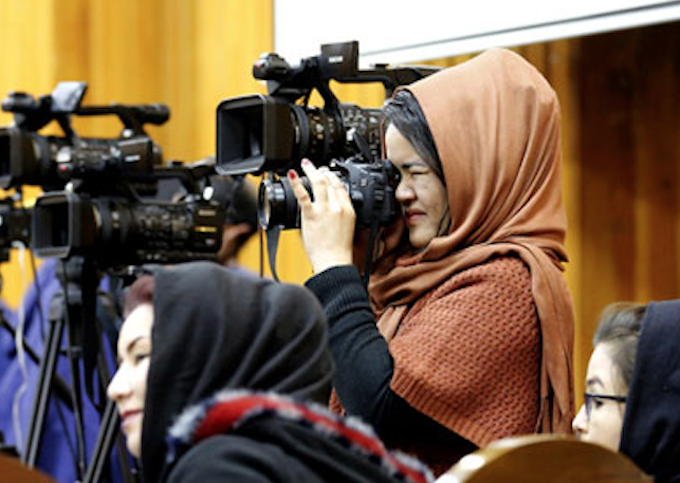
Asia Pacific Report newsdesk
Reporters Without Borders (RSF) has called on the Taliban to provide immediate guarantees for the freedom and safety of women journalists in Afghanistan, where a new media landscape is emerging from which they are missing.
This is in spite of Taliban assurances that press freedom would be respected and women journalists would be allowed to keep working.
The Taliban has announced an all-male caretaker government three weeks after taking over Kabul and the move has been criticised by UN Women as sending “the wrong signal” for a promised inclusive administration.
- READ MORE: UN agency decries exclusion of women from government
- How I left Afghanistan, with a Taliban escort to the airport
- Other Afghanistan reports
What with incidents involving Afghan women journalists since the Taliban takeover on August 15 and orders to respect Islamic laws, an RSF investigation has established that fewer than 100 women journalists are still formally working in privately-owned radio and TV stations in the Afghan capital.
According to a survey by RSF and its partner organisation, the Centre for the Protection of Afghan Women Journalists (CPAWJ), Kabul had 108 media outlets with a total of 4940 employees in 2020.
They included 1080 female employees, of whom 700 were journalists.
Of the 510 women who used to work for eight of the biggest media outlets and press groups, only 76 (including 39 journalists) are still currently working.
Disappearing from Kabul
In other words, women journalists are in the process of disappearing from the capital.
“Taliban respect for the fundamental right of women, including women journalists, to work and to practice their profession is a key issue,” RSF secretary-general Christophe Deloire said.
“Women journalists must be able to resume working without being harassed as soon as possible, because it is their most basic right, because it is essential for their livelihood, and also because their absence from the media landscape would have the effect of silencing all Afghan women.
“We urge the Taliban leadership to provide immediate guarantees for the freedom and safety of women journalists.”
Most women journalists have been forced to stop working in the provinces, where almost all privately-owned media outlets ceased operating as the Taliban forces advanced.
A handful of these women journalists are still more or less managing to work from home, but there is no comparison with 2020, when the survey by RSF and the CPAWJ established that more than 1700 women were working for media outlets in three provinces (the provinces of Kabul, Herat and Balkh, in the east, west and north of the country).
The illusion of normality lasted only a few days. Forty-eight hours after the Taliban took control of the capital, women reporters with privately-owned TV channels such as Tolonews, Ariana News, Kabul News, Shamshad TV and Khurshid TV had dared to resume talking on the air and going out to cover events.
Media executives harassed
But media executives quickly found that they were being harassed. Nahid Bashardost, a reporter for the independent news agency Pajhwok, was beaten by Taliban while doing a report near Kabul airport on 25 August.
Other tearful women journalists described how Taliban guards stationed outside their media prevented them from going out to cover stories.
Women journalists speaking on the air in the studio are tolerated almost as little as they are reporting in the field.
A woman journalist working for a radio station in the southeastern province of Ghazni said that, two days after the Taliban took control of her province, they visited the station and warned: “You are a privately-owned radio station. You can continue, but without any woman’s voice and without music.”
It is the same in Kabul. A Taliban has replaced a female anchor at state-owned Radio Television Afghanistan (RTA), who was told to “stay at home for a few days.”
Another female anchor was denied entry to the building. RTA employed 140 women journalists until mid-August.
Now, none of them dares to go back to work at the state TV channels, which are now under Taliban control.
Stay-at-home advice
Executives and editors with privately-owned media outlets that have not already decided to stop operating confirm that, under pressure, they have advised their women journalist to stay at home.
Zan TV (Dari for “Woman TV”) and Bano TV (Dari for “Mrs TV”) have ceased all activity since August 15.
These two privately owned TV channels employed 35 and 47 women journalists, respectively.
One of these journalists said: “It was the perfect job for me. I wanted to help women. Now I don’t know if I will ever be able to go back to work.”
Deprived of her job and salary, she now faces the prospect of extreme economic hardship, like many other women journalists.
Despite undertakings from Taliban spokesman Zabihullah Mujahid that women would be able to “return to work in a few days,” no measure to this effect has been announced, forcing hundreds of women journalists to stay at home, dreading an uncertain future.
On August 24, UN High Commissioner for Human Rights Michelle Bachelet said: “A fundamental red line will be the Taliban’s treatment of women and girls, and respect for their rights to liberty, freedom of movement, education, self-expression and employment, guided by international human rights norms.”
Afghanistan was ranked 122nd out of 180 countries in the 2021 World Press Freedom Index that RSF published in April.
Asia Pacific Report collaborates with Reporters Without Borders.










































